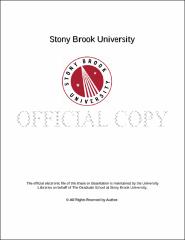| dc.identifier.uri | http://hdl.handle.net/11401/77014 | |
| dc.description.sponsorship | This work is sponsored by the Stony Brook University Graduate School in compliance with the requirements for completion of degree. | en_US |
| dc.format | Monograph | |
| dc.format.medium | Electronic Resource | en_US |
| dc.language.iso | en_US | |
| dc.publisher | The Graduate School, Stony Brook University: Stony Brook, NY. | |
| dc.type | Dissertation | |
| dcterms.abstract | Ultrarelativistic heavy-ion collisions at the CERN Large Hadron Collider (LHC) are capable of producing a medium of deconfined quarks and gluons. This phase of nuclear matter is called a Quark-Gluon Plasma (QGP) and is believed to have been present during the first microseconds following the Big Bang. \Wboson bosons are a unique probe in a QGP since they do not carry color charge and thus do not interact with a strongly-coupled medium. Furthermore, the kinematics of \Wboson bosons are sensitive to the Bjorken momentum fraction x of partons within nucleons, and therefore \Wboson bosons may also be used to constrain parton distribution functions and to detect the presence of nuclear effects. This thesis presents the measurement of \Wboson boson production in the dense nuclear environment created in \PbPb collisions at a per nucleon pair center-of-mass energy sNN−−−√=2.76\TeV. The data for this measurement were collected with the ATLAS detector in 2011 and correspond to an integrated luminosity ∫Ldt=0.14 nb−1. The production of \Wboson bosons is detected using the \wmunu decay channel, resulting in fiducial yields of 5487 ±96\stat ±86\syst \wmunup events and 5262 ±95\stat ±83\syst \wmunum events. These results are combined with yields from the corresponding electron channel \wenu, and the combined measurement is used to construct the differential production yields and lepton charge asymmetry as a function of lepton absolute pseudorapidity. The integrated production yields and charge ratio as a function of the mean number of binary nucleon-nucleon collisions \mNpart are also presented. The results are compared to predictions based on next-to-leading order QCD calculations. These observables can aid in better understanding nucleon structure within a heavy nucleus as well as provide insight into the mechanism of jet energy loss in a QGP. | |
| dcterms.abstract | Ultrarelativistic heavy-ion collisions at the CERN Large Hadron Collider (LHC) are capable of producing a medium of deconfined quarks and gluons. This phase of nuclear matter is called a Quark-Gluon Plasma (QGP) and is believed to have been present during the first microseconds following the Big Bang. \Wboson bosons are a unique probe in a QGP since they do not carry color charge and thus do not interact with a strongly-coupled medium. Furthermore, the kinematics of \Wboson bosons are sensitive to the Bjorken momentum fraction x of partons within nucleons, and therefore \Wboson bosons may also be used to constrain parton distribution functions and to detect the presence of nuclear effects. This thesis presents the measurement of \Wboson boson production in the dense nuclear environment created in \PbPb collisions at a per nucleon pair center-of-mass energy sNN−−−√=2.76\TeV. The data for this measurement were collected with the ATLAS detector in 2011 and correspond to an integrated luminosity ∫Ldt=0.14 nb−1. The production of \Wboson bosons is detected using the \wmunu decay channel, resulting in fiducial yields of 5487 ±96\stat ±86\syst \wmunup events and 5262 ±95\stat ±83\syst \wmunum events. These results are combined with yields from the corresponding electron channel \wenu, and the combined measurement is used to construct the differential production yields and lepton charge asymmetry as a function of lepton absolute pseudorapidity. The integrated production yields and charge ratio as a function of the mean number of binary nucleon-nucleon collisions \mNpart are also presented. The results are compared to predictions based on next-to-leading order QCD calculations. These observables can aid in better understanding nucleon structure within a heavy nucleus as well as provide insight into the mechanism of jet energy loss in a QGP. | |
| dcterms.available | 2017-09-20T16:51:39Z | |
| dcterms.contributor | Lacey, Roy | en_US |
| dcterms.contributor | Jia, Jiangyong | en_US |
| dcterms.contributor | Allison, Thomas | en_US |
| dcterms.contributor | Drees, Axel. | en_US |
| dcterms.creator | Balestri, Thomas Everett | |
| dcterms.dateAccepted | 2017-09-20T16:51:39Z | |
| dcterms.dateSubmitted | 2017-09-20T16:51:39Z | |
| dcterms.description | Department of Chemistry | en_US |
| dcterms.extent | 302 pg. | en_US |
| dcterms.format | Application/PDF | en_US |
| dcterms.format | Monograph | |
| dcterms.identifier | http://hdl.handle.net/11401/77014 | |
| dcterms.issued | 2016-12-01 | |
| dcterms.language | en_US | |
| dcterms.provenance | Made available in DSpace on 2017-09-20T16:51:39Z (GMT). No. of bitstreams: 1
Balestri_grad.sunysb_0771E_12888.pdf: 19887512 bytes, checksum: e422573c0e860ede147353893c80a418 (MD5)
Previous issue date: 1 | en |
| dcterms.publisher | The Graduate School, Stony Brook University: Stony Brook, NY. | |
| dcterms.subject | Particle physics -- Nuclear physics and radiation -- Nuclear chemistry | |
| dcterms.subject | CERN, electroweak, heavy-ion, LHC, W boson | |
| dcterms.title | W boson production in ultrarelativistic heavy-ion collisions at the CERN LHC | |
| dcterms.type | Dissertation | |

